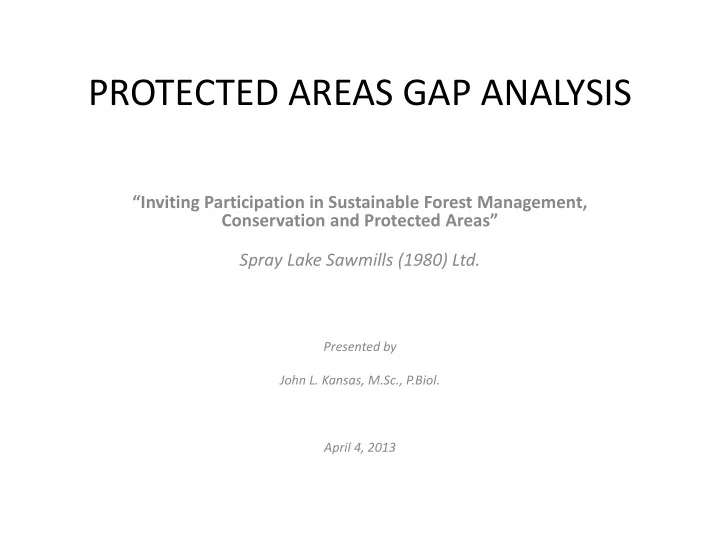

PROTECTED AREAS GAP ANALYSIS “Inviting Participation in Sustainable Forest Management, Conservation and Protected Areas” Spray Lake Sawmills (1980) Ltd. Presented by John L. Kansas, M.Sc., P.Biol. April 4, 2013
BACKGROUND • Forest Management Certification Assessment report (Rainforest Alliance - SmartWood 2012). • Indicator 6.4.1 of Criteria 6.4 requires that ..... "..... the applicant completes (or makes use of) a peer-reviewed gap analysis to address the need for protected areas in the eco- region(s) and ecodistrict(s) in which the forest is situated ". • A major NCR (04/12) was issued to SLS pertaining to Indicator 6.4.1, with the rationale being that..... ".... SLS has not completed a peer-reviewed scientific gap analysis and has not used the gap analysis and other HCVF attributes to locate additional protected areas. "
OBJECTIVES • Summarize concepts and approaches for protected area representation gap analysis; • Review the history and current status of key biodiversity elements and protected areas within and surrounding the SLS FMA and B9 Quota areas; • Identify gaps in protection of important elements of biodiversity in the SLS FMA and B9 Quota areas and region. • Demonstrate that the current and additional protected areas in the SLS's management areas contribute to long- term protection of biodiversity and that these protected areas tie into a landscape-level network.
WHAT IS GAP ANALYSIS? • Gap analysis is a planning approach that assesses the comprehensiveness of existing protected areas networks and identifies under- represented elements of biological diversity. • In its simplest form gap analysis entails comparing the distribution of key biodiversity areas with the distribution of protected areas and finding where important elements of biodiversity (i.e. habitat, ecosystems) remain unprotected or under-protec ted.
STEPS IN PROTECTED AREAS GAP ANALYSIS ** 1. Delineate the gap analysis landscape scope and scale. 2. Identify focal biodiversity and set key targets. 3. Evaluate and map occurrence and status of biodiversity. 4. Analyse and map the occurrence and status of protected areas. 5. Use the information to identify gaps. 6. Prioritise gaps to be filled. 7. Agree on a strategy and take action. ** Secretariat of the Convention on Biological Diversity (2006) WWF Canada - A Landscape-based protected areas gap analysis and GIS tool for conservation planning (2006)
Environmentally Significant Area (ESA) ".....ESAs represent places in Alberta that are important to the long-term maintenance of biological diversity, soil, water, or other natural processes, at multiple spatial scales. They are identified as areas containing rare or unique elements in the province, or areas that include elements that may require special management consideration due to their conservation needs."
Table 1. Protected Area Coverage and Targets in Alberta and SLS FMA/B9 Quota, by Natural Subregion. Natural Land Land Land Area % Provincial Provincial Provincial Protected Protected SSRP Protected FMA Passive Subregion Area Area Supply in Supply in Protected Target Areas Areas in Candidate Area Land Supply Supply in FMA FMA Area Met? in RAA FMA Protected Shortfall Base in RAA Targets Areas in FMA Alberta 1,266 km 2 21 km 2 645 km 2 1,146 km 2 54.4km 2 20 km 2 Alpine 15,084 <0.1% 100% 0 0 km 2 (4.3%) (in RAA) including 3.2 km 2 in the FMA SubAlpine 2,807 km 2 1,138 km 2 645 km 2 1,396 km 2 171km 2 507 km 2 25,218 4.5% 100% 0 0 km 2 (2.6%) (in RAA) including 5.3 km 2 in FMA 1,129km 2 754 km 2 710 km 2 8.0 km 2 3.0 km 2 5.5 km 2 * 191 km 2 Upper 21,537 3.5% 75% 0 km 2 Foothills (3.3%) (None in the FMA) Montane * 1,934 km 2 730km 2 620 km 2 329.4 km 2 2.9 km 2 238 km 2 8,768 8.3% 100% 0 0 km 2 (7.1%) (All in the FMA) 695 km 2 635 km 2 1125 km 2 11.8 km 2 188 km 2 Lower 44,899 1.4% 25% 0.0 0 0.0 km 2 Foothills (2.5%)
SHEEP RIVER/BLUEROCK Lower Foothills or Montane ? • The SLS FMA/B9 areas established in September 2001. • 3 new protected areas established to extend the East Slopes protected area: 1) Don Getty Wildland Park, 2)Bluerock Wildland ` Park and 3) Sheep River Provincial Park. • Sheep-Bluerock arose from WWF Foothills Protected Areas Gap Analysis (GAIA 1996)
GAIA (1996) REPORT FINDINGS • Assessment of the Foothills Natural Region protected areas network (GAIA 1996) • One of 12 candidate sites for protection • “It is one of the most unique areas in the southern portion of the Upper Foothills because of the proximity to the Montane Subregion ” • “Its potential connectedness to the west with the Elbow - Sheep Wildland Provincial Park is a major asset” • “The results of the report underscore the difficulty in developing an adequate protected areas network in the Foothills Natural Region because of the extent to which the land base is already fragmented by various resource and recreational activities”
Conservation Biology Institute (2007) "Functionally connecting existing and new protected areas is an important consideration in this ecoregion and the main river segments highlighted offer an important opportunity to do that both from the standpoint of aquatic and terrestrial conservation values."
CONCLUSIONS • Highest levels of biological diversity in FMA at lower elevations in Lower Foothills and Montane subregions • Alpine, Subalpine and Montane subregions fully protected • Foothills lands, especially Lower Foothills subregion, under-represented in terms of protected areas • Goal is to add protected lands in the Lower Foothills (11.8 km2) and Upper Foothills (5.5 km2) in the FMA • Good starting point is Red Deer River ESA
Recommend
More recommend